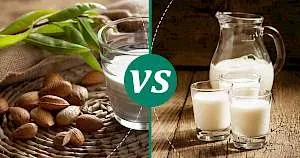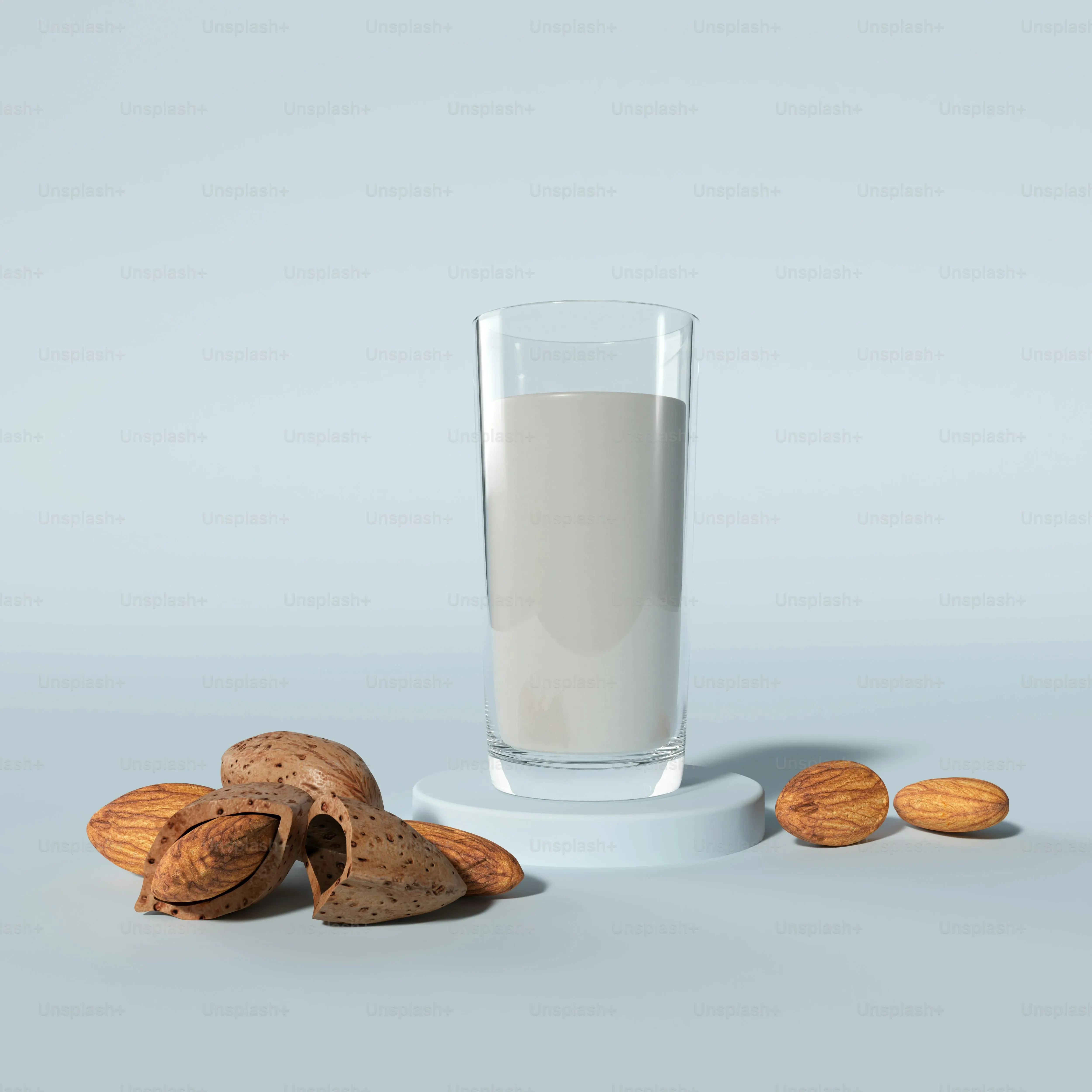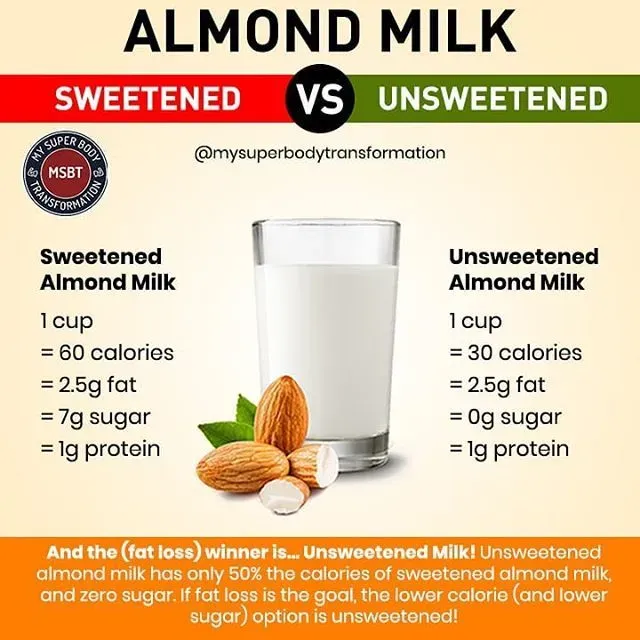Table of Contents
Walking down the dairy (or non-dairy) aisle when you're trying to shed a few pounds feels like navigating a minefield. So many options, so much conflicting advice. You're just trying to make a healthier choice for your morning coffee or cereal, and suddenly you're deep in thought comparing cartons. Two popular contenders often pop up: almond milk and good old low fat milk. Both have their fan clubs, but when it comes to dropping weight, is one truly superior?
Calories: The Big Difference in Almond Milk vs Low Fat Milk

Calories: The Big Difference in Almond Milk vs Low Fat Milk
The Raw Numbers: A Calorie Snapshot
Alright, let's cut right to the chase because when you're trying to drop pounds, calories are the first thing on your mind. This is where almond milk vs low fat milk shows its most obvious difference. A standard cup of unsweetened almond milk typically clocks in at around 30-40 calories. That's pretty low. Think about it – you can pour a decent amount without racking up a huge calorie bill.
Now, look at low fat milk, often called skim milk. A cup of that is usually around 90-100 calories. So, right off the bat, you're looking at more than double the calories in low fat milk compared to its almond counterpart. If your main strategy is simply reducing calorie intake, almond milk seems like the clear winner on this point alone.
Why Calories Matter for Weight Loss
Anyone who's ever tried to lose weight knows the golden rule: you need to burn more calories than you consume. This is your calorie deficit. The bigger the deficit (within reason, don't starve yourself), the faster you lose weight. So, choosing lower-calorie foods and drinks is a fundamental step in creating that deficit without feeling like you're eating air.
Swapping your usual low fat milk for unsweetened almond milk in your daily routine – maybe in your coffee, cereal, or smoothie – can save you 50-70 calories per cup. That might not sound like a ton, but those calories add up over a day, a week, a month. Consistency is key, and consistently saving calories helps build that deficit necessary for weight loss.
Milk Type | Approx. Calories per Cup (8oz) |
|---|---|
Unsweetened Almond Milk | 30-40 |
Skim Milk (Low Fat Milk) | 90-100 |
2% Milk | 120-130 |
Whole Milk | 150-160 |
Beware the Sweet Stuff: Not All Almond Milks Are Equal
Here’s a crucial point that trips people up: not all almond milk is created equal, especially when it comes to calories. Those low numbers we talked about? That's typically for *unsweetened* varieties. Step over to the sweetened versions, and you're adding sugar and, you guessed it, calories.
Some sweetened almond milks can jump up to 80-90 calories per cup, putting them right in the same ballpark as low fat milk. Others, like vanilla or chocolate flavors, can be even higher. So, if you grab the wrong carton, you might think you're making the lower-calorie choice in the almond milk vs low fat milk debate, but you're actually not gaining much of a calorie advantage at all. Always check the nutrition label, specifically for "unsweetened."
Protein Powerhouse: How Low Fat Milk Stacks Up Against Almond Milk

Protein Powerhouse: How Low Fat Milk Stacks Up Against Almond Milk
Protein Powerhouse: How Low Fat Milk Stacks Up Against Almond Milk
so calories are one piece of the puzzle, but protein is another big one, especially for weight loss. This is where the story takes a turn in the almond milk vs low fat milk comparison. Low fat milk is a decent source of protein. A single cup packs about 8 grams. Protein is crucial because it helps you feel full longer, which can curb snacking, and your body actually burns more calories digesting protein than fats or carbs (that's the thermic effect we heard about). Now, look at almond milk. Most unsweetened varieties offer less than 2 grams of protein per cup, sometimes as low as 1 gram. That's a pretty stark difference. If you're relying on your milk to contribute significantly to your daily protein intake, low fat milk pulls way ahead.
Beyond the Numbers: Other Nutritional Facts on Almond Milk vs Low Fat Milk

Beyond the Numbers: Other Nutritional Facts on Almond Milk vs Low Fat Milk
Fortification: Are They Adding What You Need?
so calories and protein are big players, but let's not forget the supporting cast: vitamins and minerals. Low fat cow's milk naturally contains a good amount of calcium and is often fortified with Vitamin D. These are bone-building heavyweights. Historically, milk was the go-to source for these. Now, unsweetened almond milk, in its natural state, isn't exactly bursting with these nutrients. The almonds themselves have some, sure, but not in the same league as dairy.
Here's where fortification becomes key in the almond milk vs low fat milk debate beyond just the big macros. Most commercial almond milks are heavily fortified to mimic the nutrient profile of cow's milk. They'll add calcium, Vitamin D, Vitamin E, and sometimes Vitamin A. So, on paper, a fortified almond milk might look nutritionally similar to low fat milk for these specific nutrients. But it's added, not naturally occurring. Does that matter? Some folks think so. It’s worth checking the label to see just how much is packed in there.
Fats, Fiber, and What Else Is Hiding?
When you're looking at low fat milk, the name tells you a lot: it's got minimal fat, usually under 0.5 grams per cup. It also contains lactose, a sugar that gives some people digestive grief. Almond milk, particularly the unsweetened kind, also has very little fat – often around 2.5 grams per cup, mostly unsaturated fats from the almonds. It contains no lactose, which is a major plus for those who are intolerant.
However, almond milk often contains thickeners and stabilizers like carrageenan or gellan gum to give it a texture closer to dairy. These are generally considered safe, but some people report digestive issues with them. Low fat milk is pretty much just milk, maybe with added vitamins. Also, almond milk has a tiny bit of fiber, which low fat milk lacks entirely, though the amount in a serving isn't significant enough to make a huge impact on satiety or digestion for most people.
- Low fat milk offers natural calcium and Vitamin D (often fortified).
- Almond milk is heavily fortified to add calcium, Vitamin D, E, and A.
- Low fat milk contains lactose; almond milk does not.
- Almond milk may contain thickeners and stabilizers.
- Neither is a significant source of dietary fiber per serving.
Which Milk Wins for Weight Loss: Almond Milk or Low Fat?

Which Milk Wins for Weight Loss: Almond Milk or Low Fat?
The Calorie Count Perspective
so we've laid out the raw numbers. From a purely calorie-saving standpoint, unsweetened almond milk takes the crown. If your primary focus is simply reducing your daily caloric intake to create that necessary deficit, swapping out higher-calorie drinks for something like 30-calorie almond milk is a no-brainer. Think about it: a daily latte made with skim milk versus one made with unsweetened almond milk could save you hundreds of calories a week. Over time, that adds up. It's not a magic potion, but it's a simple, tangible way to chip away at your energy intake without feeling deprived, assuming you enjoy the taste.
Protein's Role in Satiety and Metabolism
But hold on, calories aren't the only factor in the almond milk vs low fat milk weight loss debate. Protein matters, arguably a lot. Low fat milk, with its 8 grams per cup, offers significantly more protein than almond milk's measly 1-2 grams. Why is this a big deal for weight loss? Protein is king when it comes to making you feel full. It digests slower than carbs or fats, keeping those hunger pangs at bay longer. Plus, your body actually burns more calories just processing protein. So, while low fat milk has more calories upfront, the protein punch might help you eat less later in the day or boost your metabolism slightly. It's a trade-off: fewer calories initially with almond milk, or more protein for potential satiety with low fat milk.
Feature | Unsweetened Almond Milk | Low Fat Milk |
|---|---|---|
Calories (per cup) | Lower (30-40) | Higher (90-100) |
Protein (per cup) | Very Low (1-2g) | High (8g) |
Satiety Potential | Lower | Higher (due to protein) |
Calcium/Vit D (Natural) | Low (often fortified) | High (often fortified) |
Lactose | None | Present |
The Verdict: It Depends on Your Strategy
So, which milk wins for weight loss? The unsatisfying but honest answer is: neither is a universal champion; it really depends on your overall diet strategy and what works best for you. If you're strictly counting calories and need to shave off every last one, unsweetened almond milk offers a clear advantage. However, if you struggle with hunger or want to maximize protein intake to support muscle mass (which helps burn calories), low fat milk might be the better fit despite the higher calorie count. Some people find the protein in low fat milk genuinely helps them stick to their calorie goals by reducing snacking. Others find the lower calorie count of almond milk gives them more flexibility elsewhere in their diet. Neither milk magically melts fat. They are tools to help you manage your calorie and nutrient intake within a broader weight loss plan. Choose the one you like, can afford, and that helps you stick to your deficit.
Fitting Almond Milk or Low Fat Milk into Your Diet Plan

Fitting Almond Milk or Low Fat Milk into Your Diet Plan
Making Your Morning Routine Work
so you've weighed the pros and cons of almond milk vs low fat milk for your own situation. Now, how do you actually use it without messing up your calorie goals? It starts with your daily habits. If you're a cereal person, measure your milk. Eyeballing that pour can easily add an extra half serving, and those calories count, whether it's 20 extra from almond milk or 50 from low fat. Coffee drinkers, be mindful of lattes and cappuccinos; the milk volume adds up fast. A splash in black coffee is one thing, but a full cup steamed into a fancy drink is another. Unsweetened almond milk gives you more room to play here calorie-wise, but low fat milk adds protein that might make that coffee feel more substantial and hold you over longer.
Maximizing Benefits and Avoiding Pitfalls
Whichever milk you lean towards, use it strategically. If you pick low fat milk for its protein, pair it with a fiber source like oats or berries to create a truly satisfying breakfast that keeps you full. Don't just drink a glass on its own and expect miracles. If you go with unsweetened almond milk to save calories, be aware it won't contribute much to satiety on its own. Make sure the rest of your meal or snack is balanced with protein and fiber so you're not hungry again in an hour. And seriously, double-check that almond milk carton isn't the sweetened kind lurking in your fridge – that's a rookie mistake that costs you calories you thought you were saving in the almond milk vs low fat milk swap.
- Measure your milk servings for cereals and drinks.
- Use unsweetened almond milk to keep calories lowest.
- Pair low fat milk (for protein) with fiber-rich foods.
- Don't rely on almond milk for satiety; balance your meal.
- Always check the label for "unsweetened" on almond milk.
Consistency and Finding Your Fit
Ultimately, the best milk for your weight loss plan is the one you'll actually stick with consistently. It doesn't matter if unsweetened almond milk theoretically saves you 60 calories if you hate the taste and end up adding sugar anyway, or if low fat milk's protein is great on paper but it upsets your stomach. Experiment to see which one fits best into your meals and snacks and, importantly, which one you enjoy enough to keep using day after day within your calorie budget. Neither milk is a magic bullet, but used mindfully as part of a balanced, calorie-controlled diet, either can be a perfectly fine choice in the great almond milk vs low fat milk debate.
The Final Sip: Almond Milk vs Low Fat Milk for Weight Loss
So, after looking at the numbers, what's the verdict in the almond milk vs low fat milk debate for weight loss? It's less about a knockout punch and more about picking the right tool for your personal calorie budget. Almond milk, especially unsweetened, generally brings fewer calories to the table, which can be helpful if you're watching every single one. Low fat milk, however, packs significantly more protein. That protein can help you feel fuller and potentially burn a tiny bit more energy during digestion. Neither is a magic bullet; liquid calories, regardless of the source, don't always fill you up like solid food. The choice boils down to whether you prioritize lower calories (almond milk) or higher protein (low fat milk) within your overall eating plan. Find the one you like and can stick with, because consistency in a calorie deficit is what truly moves the needle.
